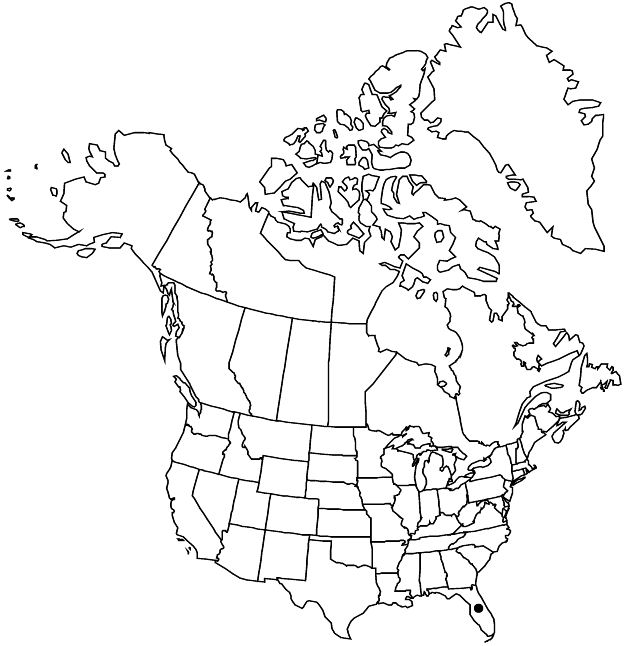Difference between revisions of "Hibiscus schizopetalus"
Bot. Mag. 106: plate 6524. 1880.
FNA>Volume Importer |
imported>Volume Importer |
||
| Line 34: | Line 34: | ||
|elevation=0–50 m | |elevation=0–50 m | ||
|distribution=Fla.;e Africa;introduced also in Mexico;West Indies;Central America;South America;s Asia;elsewhere in Africa;Pacific Islands;Australia. | |distribution=Fla.;e Africa;introduced also in Mexico;West Indies;Central America;South America;s Asia;elsewhere in Africa;Pacific Islands;Australia. | ||
| + | |introduced=true | ||
|discussion=<p>Apparently native only in Kenya, Tanzania, and perhaps Mozambique, <i>Hibiscus schizopetalus</i> is widely cultivated in the Tropics and occasionally escapes. The occurrence in many <i>H. rosa-sinensis</i> cultivars of semipendulous, long-pedicelled flowers with variously</p><!-- | |discussion=<p>Apparently native only in Kenya, Tanzania, and perhaps Mozambique, <i>Hibiscus schizopetalus</i> is widely cultivated in the Tropics and occasionally escapes. The occurrence in many <i>H. rosa-sinensis</i> cultivars of semipendulous, long-pedicelled flowers with variously</p><!-- | ||
--><p>crenate, undulate petals suggests the involvement of <i>H. schizopetalus</i>. Hybrids between <i>H. schizopetalus</i> and <i>H. rosa-sinensis</i> can be called H. ×archeri W. Watson. Typification of <i>H. schizopetalus</i> was discussed by M. Cheek (1989).</p> | --><p>crenate, undulate petals suggests the involvement of <i>H. schizopetalus</i>. Hybrids between <i>H. schizopetalus</i> and <i>H. rosa-sinensis</i> can be called H. ×archeri W. Watson. Typification of <i>H. schizopetalus</i> was discussed by M. Cheek (1989).</p> | ||
| Line 59: | Line 60: | ||
|publication year=1880 | |publication year=1880 | ||
|special status=Introduced | |special status=Introduced | ||
| − | |source xml=https:// | + | |source xml=https://bibilujan@bitbucket.org/aafc-mbb/fna-data-curation.git/src/bb6b7e3a7de7d3b7888a1ad48c7fd8f5c722d8d6/coarse_grained_fna_xml/V6/V6_471.xml |
|subfamily=Malvaceae subfam. Malvoideae | |subfamily=Malvaceae subfam. Malvoideae | ||
|genus=Hibiscus | |genus=Hibiscus | ||
Revision as of 23:40, 27 May 2020
Shrubs or trees, to 3(–5) m. Stems: new growth essentially glabrous, lines of curved hairs absent. Leaves: stipules narrowly triangular, 1–2.5 mm; petiole to 1/3 blade, adaxial groove hairy with minute, ± sinuous hairs; blade lanceolate-ovate to ovate, unlobed, 3.5–10.5 × 1.5–4 cm, base rounded to cuneate, margins coarsely serrate in distal 2/3–3/4, apex acute to short-acuminate, ± pinnately veined, surfaces glabrate, nectary present abaxially on midvein near base. Inflorescences solitary flowers in axils of distal leaves. Pedicels jointed at middle or distally, 7.5–15 cm; involucellar bractlets 6–8, triangular, 0.06–0.18 cm, margins not ciliate. Flowers pendulous; calyx divided 1/8–1/2 length, often 3-lobed, tubular to narrowly funnelform, (1–)1.4–2 cm, lobes broadly triangular, apices acute to obtuse, glabrate, neither accrescent nor inflated, nectaries absent; petals strongly recurved, rose-pink to red, darker on veins, broadly to narrowly obovate, deeply and irregularly pinnatifid-laciniate, 4–6.5 × 1.5–3.5 cm, glabrous; staminal column straight or curved apically, pendulous, pink to red, 5.5–9 cm, bearing filaments in distal 1/3–1/2, free portion of filaments not secund, 4.5–7.5 mm; pollen yellow; styles pink to red, 7–15 mm; stigmas pink to red. Capsules brown, oblong-cylindric, 3.5–4 cm, glabrous or puberulent. Seeds brown, angulately reniform-ovoid, 2–3 mm, smooth, glabrous or puberulent. 2n = 34, 40, 42, 45 (all cultivars).
Phenology: Flowering year-round.
Habitat: Disturbed sites
Elevation: 0–50 m
Distribution

Introduced; Fla., e Africa, introduced also in Mexico, West Indies, Central America, South America, s Asia, elsewhere in Africa, Pacific Islands, Australia.
Discussion
Apparently native only in Kenya, Tanzania, and perhaps Mozambique, Hibiscus schizopetalus is widely cultivated in the Tropics and occasionally escapes. The occurrence in many H. rosa-sinensis cultivars of semipendulous, long-pedicelled flowers with variously
crenate, undulate petals suggests the involvement of H. schizopetalus. Hybrids between H. schizopetalus and H. rosa-sinensis can be called H. ×archeri W. Watson. Typification of H. schizopetalus was discussed by M. Cheek (1989).
Selected References
None.